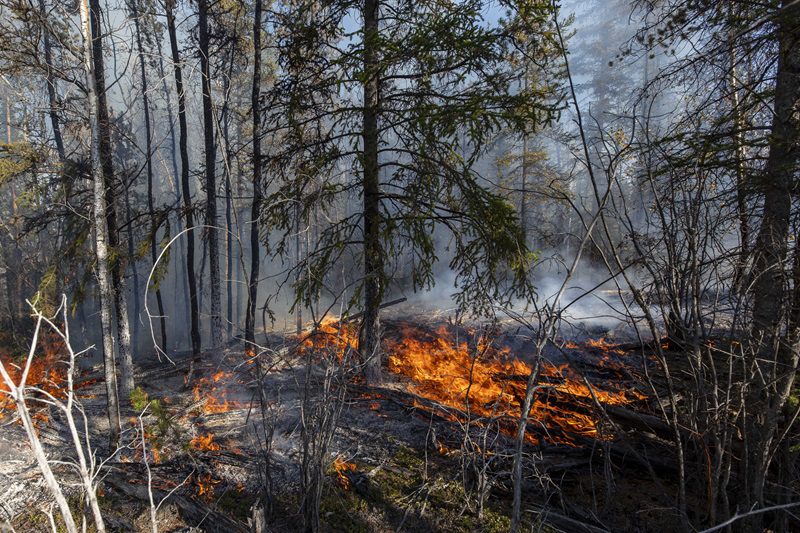Flood and fire preparedness measures underway in N.W.T. town

The Town of Hay River has been through a lot over the last couple of years, having first contended with serious flooding in 2022 and then devastating wildfires in 2023.
With the memories of those crises still fresh in the minds of residents, and another flood and fire season rapidly approaching, local leaders have been hard at work preparing for the possibility of future challenges.
“The flood event in 2022 then the wildfire of last year have emphasized the need to be more resilient and to invest more resources into not only preparedness and recovery, but mitigation,” said Glenn Smith, the senior administrative officer (SAO) of the community of about 3,500 people.
“We’re approaching it from all three of those angles of emergency management preparedness.”
In early April, The Town of Hay River and the Local Emergency Management Organization released a public notice outlining 19 measures that have already been implemented to prepare for the threat of future floods and fires. That includes the restructuring of several roadways to mitigate flood risks, the creation of new fire evacuation plans and efforts to improve communication with residents.
“Some of this is years in the making, and some of it is new, especially that which focuses on wildfire protection,” Smith said. “We’re emphasizing more wildfire preparedness this year than we have in the past. We want to keep investing in building mitigation systems and building resiliency.
“There’s a lot more to come,” he added, laying out plans for several community meetings over the coming weeks, and the launch of a “revamped” website that will have “more preparedness information on it, both for flooding and wildfires.”
So far, the risk of serious flooding around Hay River seems low, according to Smith.
“Overall, as we’ve indicated in our [public notice], the water levels are quite low this year, so that’s favourable for us,” he said.
As for the threat of fire, the community is unfortunately experiencing drought conditions, which increases the risk. However, Smith is hopeful that the fire breaks created by last year’s blazes should shield the community from further devastation this year.
Related: Price tag for the insured wildfire losses in Northwest Territories
“A significant amount of fuel in the area was burnt during that wildfire,” he said, referencing the great swaths of trees that were consumed last year. “We wouldn’t expect to see anything of the same magnitude without that fuel, but it is supposed to be dry. We’re still in drought conditions, and we expect that throughout the summer, so it’s important that people be diligent because fires can start anywhere.”
Smoke from wildfires in other areas of the territory and country is also a concern, Smith acknowledged, especially for people with respiratory conditions.
He and his team have also taken measures to reduce those potential risks.
“We expect we’re going to see a lot of smoke, even if there aren’t fires directly within our area,” he said. “We expect Alberta to have a difficult year, and B.C., and other areas of the Northwest Territories.
“We’re integrating that into our own planning, working with Environmental Health and other [GNWT] departments to look at options, particularly for those with sensitivities to smoke, so that they can have areas within the community that provide cleaner air through clean air shelters.”
Hay River is also bracing to host residents of other communities that may be forced to evacuate, Smith said.
Even with so many preparedness measures underway, the SAO is aware that residents are feeling apprehensive as the flood and fire seasons approach — particularly given that the two seasons could potentially overlap.
“I’m not sure that what we’ve experienced is a new norm, but we’ve had some pretty extreme events and got through extreme events in Hay River,” he said. “There was trauma incurred through the events, especially the wildfire, and how quickly that occurred and got on top of us. People are aware that there’s still these winter burns occurring, and they’re aware of the drought conditions, so I think there’s still a lot of anxiety.”
He hopes that his team’s efforts to safeguard the community will help put minds at ease, and urged his neighbours to remember the importance of communication throughout whatever may arise.
“I think the public can see that there is a lot of work being done, which should calm some fear,” he said.
“Everyone has a role in emergency preparedness, from property owners and residents through the multiple layers of government,” he added. “The key thing is communication.”
By Tom Taylor, Local Journalism Initiative Reporter, NWT News/North
Feature image: Small spot fires continued to flare up alongside Northwest Territories highways leading into Hay River, Fort Smith and Yellowknife, Friday, Sept. 15, 2023. Depending on wind conditions, and potential threats to infrastructure, cabins or communities, these fires are often left unattended while crews concentrate on protecting major exposures. Persistent warm weather, breezy days and weeks of drought are prolonging a northern fire season that normally quiets considerably by this time of year. THE CANADIAN PRESS/Bill Braden



